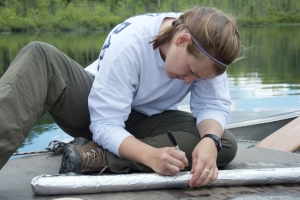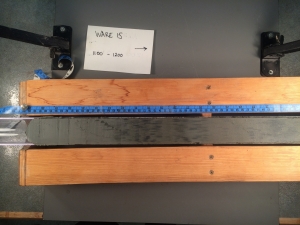You are here
Getting to the Bottom of Paleoecology
This summer I have been inducted into a prestigious group on the Harvard Forest grounds known as Club Paleo. The lucky few of us that work in the paleoecology lab attempt to decode climate and forest ecology conditions from thousands of years ago in order to infer how changes in the past could help predict how climate will change in the future. This research is conducted by gathering quantitative data from sediment cores extracted from lakes and ponds throughout New England.
With my mentor Wyatt Oswald and researcher Elaine Doughty, this summer I have helped with the extraction of two new sediment cores and I have done my best to contribute to the lab's ongoing LTER project. It has been an exciting few months of new experiences and expanding horizons, and a lot of personal development as a scientist.
By determining at what depths (which are representative of different ages) more fires likely occurred close to the ponds, we can infer what periods in the ponds' histories were deposited in times of drier climates. This data can then be used to support hypotheses regarding probable causes of ecosystem changes in the region, such as what caused a collapse in the population of eastern hemlock trees 5,500 years ago.
 Answers to questions such as this one can be helpful when applied to present problems, such as the ongoing collapse of hemlock populations due to hemlock woolly adelgid infestation, and whether its population can rebound like it has before.
Answers to questions such as this one can be helpful when applied to present problems, such as the ongoing collapse of hemlock populations due to hemlock woolly adelgid infestation, and whether its population can rebound like it has before.
The second portion of my summer research has centered around Ware Pond in Marblehead on the north shore of Massachusetts. The pond was cored once in late 2014 and we cored it again this June, with the intention that I would begin collecting data on the second core and throughout my senior year of college develop the data extracted from this core into a thesis project with a focus in geology.
The question at the heart of this undertaking has to do with the sea temporarily transgressing several miles over the shoreline after the final retreat of glacial ice at the end of the last major glacial period. As the ice retreated, the sea flowed over the continent, which had been depressed and pushed downward by the sheer mass of the ice. The sea deposited marine mud over the shore, in a stratigraphic layer called the Presumpscot Formation before the continental crust underwent isostatic rebound and rose more than 300 meters vertically.
In the next year I will attempt to determine whether the clay at the bottom of the Ware Pond core is in fact from the Presumpscot Formation, which is not believed to have extended south into Massachusetts, or whether it could be a wing of the Boston Blue Clay layer.
With this question in mind, this summer I have had the opportunity to begin collecting quantitative data on the new core from Ware Pond, including measuring the magnetic susceptibility of all 12.5 meters, and measuring the percent organic content through loss on ignition analysis. Armed with this data and a new knowledge of and respect for the impact that paleo-climates have on sediment deposition, I am eager to continue unraveling the mysteries of Ware Pond's past.


